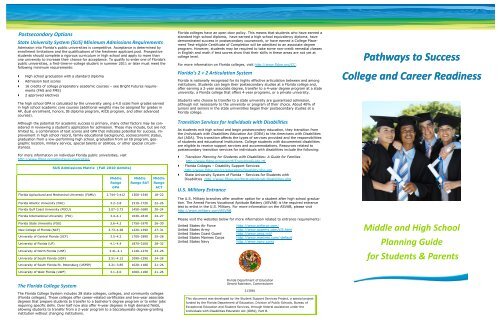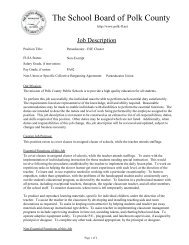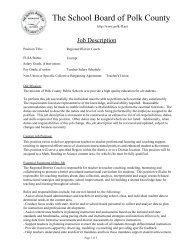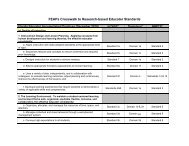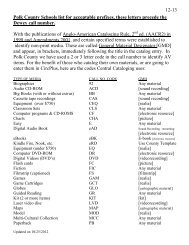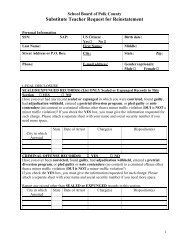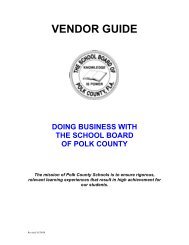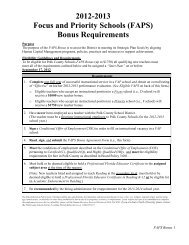District Resource Guide - Polk County School District
District Resource Guide - Polk County School District
District Resource Guide - Polk County School District
You also want an ePaper? Increase the reach of your titles
YUMPU automatically turns print PDFs into web optimized ePapers that Google loves.
Postsecondary Options<br />
State University System (SUS) Minimum Admissions Requirements<br />
Admission into Florida’s public universities is competitive. Acceptance is determined by<br />
enrollment limitations and the qualifications of the freshmen applicant pool. Prospective<br />
students should complete a rigorous curriculum in high school and apply to more than<br />
one university to increase their chance for acceptance. To qualify to enter one of Florida’s<br />
public universities, a first-time-in-college student in summer 2011 or later must meet the<br />
following minimum requirements:<br />
High school graduation with a standard diploma<br />
Admission test scores<br />
16 credits of college preparatory academic courses – see Bright Futures requirements<br />
(FAS and FMS)<br />
2 approved electives<br />
The high school GPA is calculated by the university using a 4.0 scale from grades earned<br />
in high school academic core courses (additional weights may be assigned for grades in<br />
AP, dual enrollment, honors, IB diploma program, AICE program, and other advanced<br />
courses).<br />
Although the potential for academic success is primary, many other factors may be considered<br />
in reviewing a student’s application for admission. These may include, but are not<br />
limited to, a combination of test scores and GPA that indicates potential for success, improvement<br />
in high school record, family educational background, socioeconomic status,<br />
graduation from a low–performing high school, graduation from an IB program, geographic<br />
location, military service, special talents or abilities, or other special circumstances.<br />
For more information on individual Florida public universities, visit<br />
http://www.flbog.org/aboutsus/universities.<br />
SUS Admissions Matrix (Fall 2010 Admits)<br />
Middle<br />
Range<br />
GPA<br />
Middle<br />
Range SAT<br />
Middle<br />
Range<br />
ACT<br />
Florida Agricultural and Mechanical University (FAMU) 2.744–3.412 1300–1540 18–22<br />
Florida Atlantic University (FAU) 3.2–3.8 1510–1720 22–26<br />
Florida Gulf Coast University (FGCU) 3.07–3.73 1450–1680 20–24<br />
Florida International University (FIU) 3.4–4.1 1630–1810 24–27<br />
Florida State University (FSU) 3.6–4.2 1750–1970 26–30<br />
New College of Florida (NCF) 3.73–4.28 1220–1390 27–31<br />
University of Central Florida (UCF) 3.5–4.2 1700–1890 25–28<br />
University of Florida (UF) 4.1–4.4 1870–2100 28–32<br />
University of North Florida (UNF) 3.41–4.1 1140–1270 23–26<br />
University of South Florida (USF) 3.51–4.12 1090–1290 24–28<br />
University of South Florida St. Petersburg (USFSP) 3.21–3.85 1020–1180 21–26<br />
University of West Florida (UWF) 3.1–4.0 1000–1180 21–26<br />
Florida colleges have an open door policy. This means that students who have earned a<br />
standard high school diploma, have earned a high school equivalency diploma, have<br />
demonstrated success in postsecondary coursework, or have earned a College Placement<br />
Test-eligible Certificate of Completion will be admitted to an associate degree<br />
program. However, students may be required to take some non-credit remedial classes<br />
in English and math if test scores show that their skills in these areas are not yet at<br />
college level.<br />
For more information on Florida colleges, visit http://www.fldoe.org/CC.<br />
Florida’s 2 + 2 Articulation System<br />
Florida is nationally recognized for its highly effective articulation between and among<br />
institutions. Students can begin their postsecondary studies at a Florida college and,<br />
after earning a 2-year associate degree, transfer to a 4-year degree program at a state<br />
university, a Florida college that offers 4-year programs, or a private university.<br />
Students who choose to transfer to a state university are guaranteed admission,<br />
although not necessarily to the university or program of their choice. About 40% of<br />
juniors and seniors in the state universities began their postsecondary studies at a<br />
Florida college.<br />
Transition Services for Individuals with Disabilities<br />
As students exit high school and begin postsecondary education, they transition from<br />
the Individuals with Disabilities Education Act (IDEA) to the Americans with Disabilities<br />
Act (ADA). This transition affects the types of services provided and the responsibilities<br />
of students and educational institutions. College students with documented disabilities<br />
are eligible to receive support services and accommodations. <strong>Resource</strong>s related to<br />
postsecondary transition services for individuals with disabilities include the following:<br />
Transition Planning for Students with Disabilities: A <strong>Guide</strong> for Families<br />
http://www.fldoe.org/ese/rtf/Transition<strong>Guide</strong>.rtf<br />
Florida Colleges – Disability Support Services<br />
http://www.fldoe.org/cc/educators/Disability/dss.asp<br />
State University System of Florida – Services for Students with<br />
Disabilities http://www.flbog.org/forstudents/ati/disabilities.php<br />
U.S. Military Entrance<br />
The U.S. Military branches offer another option for a student after high school graduation.<br />
The Armed Forces Vocational Aptitude Battery (ASVAB) is the required entrance<br />
test to enlist in the U.S. Military. For more information on the ASVAB, please visit<br />
http://www.military.com/ASVAB.<br />
Please visit the websites below for more information related to entrance requirements:<br />
United States Air Force<br />
United States Army<br />
United States Coast Guard<br />
United States Marines Corps<br />
United States Navy<br />
http://www.airforce.com/<br />
http://www.goarmy.com/cl5.html<br />
http://www.uscg.mil/<br />
http://www.marines.com/-default<br />
http://www.navy.com/<br />
Pathways to Success<br />
College and Career Readiness<br />
Middle and High <strong>School</strong><br />
Planning <strong>Guide</strong><br />
for Students & Parents<br />
The Florida College System<br />
The Florida College System includes 28 state colleges, colleges, and community colleges<br />
(Florida colleges). These colleges offer career-related certificates and two-year associate<br />
degrees that prepare students to transfer to a bachelor’s degree program or to enter jobs<br />
requiring specific skills. Over half now also offer 4-year degrees in high demand fields,<br />
allowing students to transfer from a 2-year program to a baccalaureate degree-granting<br />
institution without changing institutions.<br />
Florida Department of Education<br />
Gerard Robinson, Commissioner<br />
313081<br />
This document was developed by the Student Support Services Project, a special project<br />
funded by the Florida Department of Education, Division of Public <strong>School</strong>s, Bureau of<br />
Exceptional Education and Student Services, through federal assistance under the<br />
Individuals with Disabilities Education Act (IDEA), Part B.


